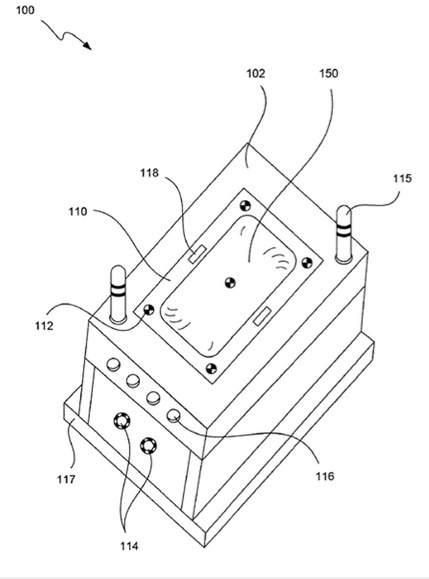An Apple patent (number 20120302670) for a carbon composite mold design has appeared at the U.S. Patent & Trademark Office.
Per the patent a mold assembly or system includes a moldbase that holds mold inserts and has embedded fluid lines to facilitate cooling during part formation. Mold inserts combine to form mold cavities that receive carbon fiber and resin components to form a carbon composite based part. A permanent release coating along a mold component surface that contacts the carbon fiber and resin components facilitates the release of the finished part from the mold component.
Guide pins and guide pin receiving holes facilitate accurate alignment of mold components. Ejector pins within respective ejector pin shafts help eject a finished part from a respective mold component. An ejector pin shaft cover transfers force from an ejector pin to eject a finished part and also prevents substantial passage of resin into the ejector pin shaft. A fluid actuated ejection system provides fluid based mechanical forces to the ejector pins to facilitate finished part ejection.
Here’s Apple’s background on the invention: “There are currently a wide number of known ways to form aesthetically pleasing parts and components for items made from various materials across many industries. For example, general part formation can be had by way of machining, casting, stamping, extrusion, cold drawing and injection molding, among numerous other alternatives. Where particularly strong parts or components are desired, another common part formation process can involve composite molding.
“Composite molding generally involves molding a combination of different materials, each having a particular mechanical strength in a different direction, to form a final product that has mechanical strengths in multiple directions. Many popular forms of composite molding involve the use of carbon fibers or another similar component and a resin material, the molded combination of which results in a relatively strong part or component, particularly with respect to the weight of the part. Generally, fibers and resin are placed over or into a mold and are then cured under increased heat and pressure. Fibers typically come in sheet form, which can include “prepreg” or resin impregnated sheets, and are often layered into the mold sheet by sheet. Such a layering process is often performed manually by an operator, as are other steps in a typical composite molding of a part.
“Because resins tend to stick to mold surfaces, removal of a finished part from a mold can be a tricky process that often also involves manual intervention by an operator. Despite the application of a temporary release coating to inner mold surfaces prior to placing in the composite materials, the removal of a finished part from a composite mold still can involve prying and peeling the part away from the inner mold surfaces.
“Surface defects and blemishes on composite molded parts often occur as a part of the molding and mold removal process, which results in many parts having unique defects or appearances. Further, temperature discrepancies from molded part to molded part using traditional composite molding processes can also result in blemishes or defects that are different for each part. Due to these particular examples and other concerns that relate to composite molding, many composite molding processes are highly manual labor intensive by nature, and often result in the formation of parts that are not fully consistent from part to part.
“This is unfortunate in that many manufacturers might desire the mass production of consistent parts that have the strength of carbon composite components. As but one example, it would be particularly helpful if portable electronic device housings and components could be stronger and more durable than what is now typically provided in plastic parts that are formed via ordinary plastic injection molding processes. In particular, it would be beneficial if laptops, notebook computers, and other relatively large and heavy portable computing devices could have outer housings that are better able to protect the entire device from drops and other mechanical shocks.
“Although a material having the toughness of a good carbon composite would be useful, the ability to mass produce laptop housings that are consistent in appearance and performance from such a material would be difficult. Of course, there are a myriad of other examples of parts where it would be desirable to form them from a stronger material such as a carbon composite.
“While many designs and methods of manufacture for providing composite molded parts and components have generally worked well in the past, there is always a desire to provide new and improved designs and processes that result in functional and aesthetically pleasing composite parts that can be mass produced. In particular, it is desirable to provide a carbon composite molding apparatus and process that allows for a more automated mass production of consistent carbon composite parts, such as for computer housings and the like.”
The inventors are Paul Choiniere, Glenn Aune, John DiFonzo, Daniel Hong and Kevin Kenney.




